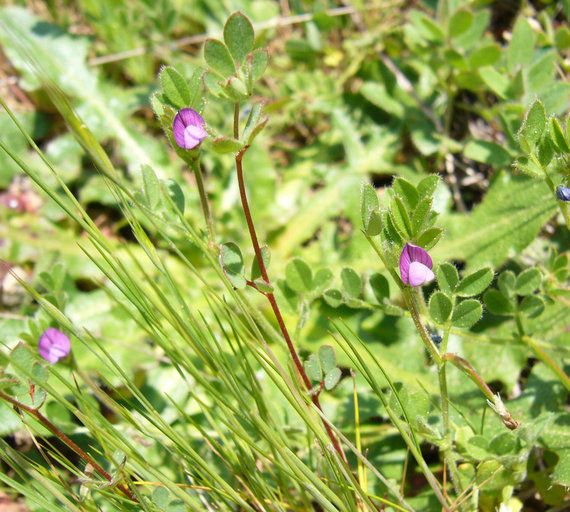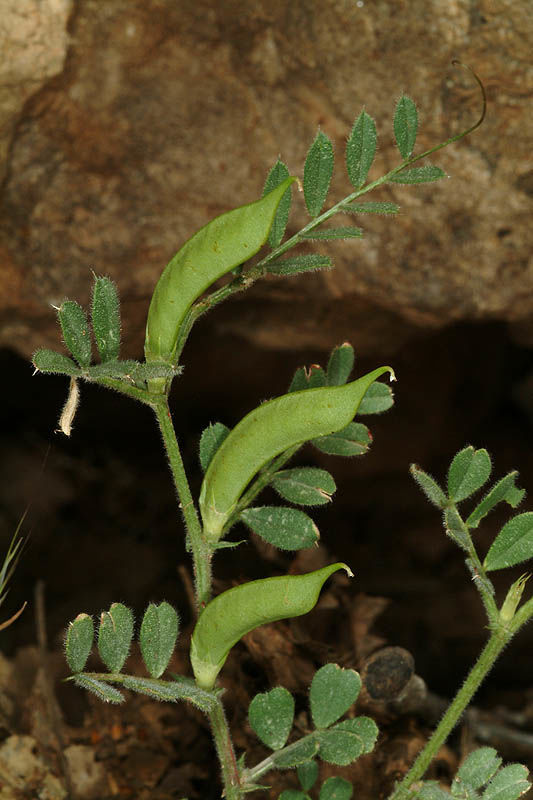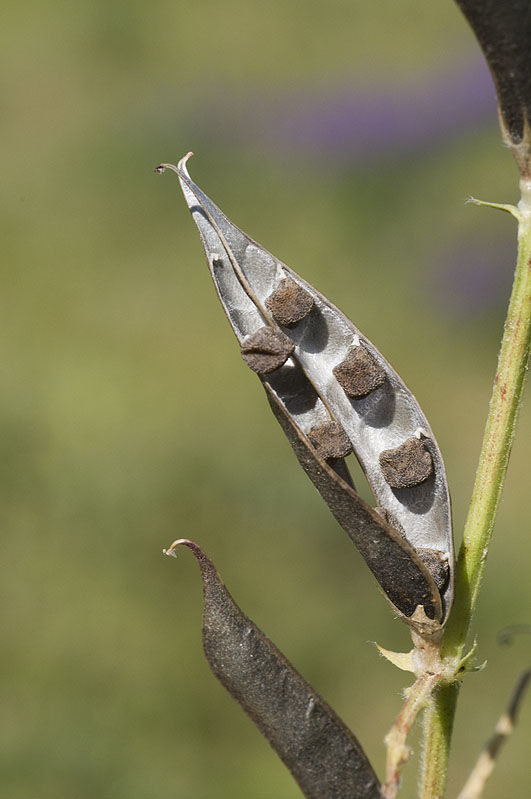Spring Vetch
vicia lathyroides
Also known as: ["Spring Vetchling","Spring Vetchling Pea"]
Overview
A small annual legume with delicate, pea-like flowers, typically blooming in early spring.
Benefits & Perks
["wildlife attractant (bees, butterflies, birds)","low maintenance","seasonal color change"]
Botanical Classification
| Phylum: | Magnoliophyta |
| Class: | Magnoliopsida |
| Order: | Fabales |
| Family: | Fabaceae |
| Genus: | Vicia |
| Botanical Name: | Vicia lathyroides |
Plant Characteristics
Basic Information
- Category: Flowers
- Suitable Location: garden bed or container in a location with good air circulation
- Suitable For:
- Is Weed: No
- Allergenicity: low
Environmental Needs
- Climate: {"temperatureRange":"5–25°C"}
- Hardiness: {"zones":"5–8"}
- Misting: rarely required, only if ambient humidity is very low
- Drainage: Fast-draining to prevent waterlogging.
- Soil Type: Well-draining, loamy soil with some organic matter; tolerates poor soils but thrives with moderate fertility.
Maintenance Level
- Maintenance Level: low
- Toughness Level: moderate
- Pruning Frequency: As needed; after flowering or when plants become overgrown.
- Pruning Intensity: Light to moderate; remove only dead or diseased parts.
Care Details
Ideal Sunlight Coverage:
Full sun to partial shade; 6–8 hours of direct sunlight per day; adjust based on intensity and season.
Sunlight Tolerance Tips:
Acclimate seedlings gradually to direct sun; protect from harsh midday sun in hot climates; provide dappled shade in intense heat.
Care Requirements
Care Difficulty
easyeasy
Sunlight
full sun to partial shade
Rotate plants for even growth; use shade cloth if needed; monitor for sunburn signs.
Watering
every 7–10 days during active growth, reduce in winter
Water deeply but infrequently; ensure good drainage; adjust based on weather and soil moisture.
Soil
well-drained, sandy loam with moderate organic matter
pH: Slightly acidic to neutral (pH 6.0–7.0).
Ensure soil is loose and airy; avoid compacted soil; maintain consistent moisture levels.
Temperature
Cool to moderate temperatures; ideal range 50–70°F (10–21°C); tolerates mild frosts but prefers cooler conditions.
Monitor nighttime temperatures; protect from sudden temperature swings; adjust care based on seasonal changes.
Fertilizing
every 4–6 weeks during spring and summer
Fertilize every 4–6 weeks during growing season; avoid over-fertilizing to prevent nutrient burn; stop fertilizing before flowering begins.
Propagation
Methods
Seed propagation is the most common method; direct sow in fall or early spring for best results.
Step-by-Step Propagation Guide
- Prepare soil.
- Sow seeds 1/4 inch deep.
- Keep moist.
- Thin seedlings if overcrowded.
- Transplant if needed.
Best Time: Early spring or fall when temperatures are mild and soil is workable.
Environment
Cool temperatures, consistent moisture, and partial shade for seedlings; full sun once established.
Medium
Well-draining soil mix; can be sown directly in garden beds or pots.
Hormone
Not required for seed propagation.
Timeline
Seeds germinate in 2–4 weeks under optimal conditions; plants establish quickly in the first growing season.
Tools Needed
Garden trowel, watering can, seed trays (optional), labels.
Quick Tips
Sow seeds in groups for better germination rates; keep soil consistently moist but not waterlogged; protect seedlings from pests.
Pruning & Repotting
Pruning Guide
Method
Snip off dead or yellowing leaves at the base; trim back straggly stems to encourage bushier growth.
Pruning Plan
Minimal pruning required; focus on removing dead or damaged foliage to maintain plant health and appearance.
Tools
Pruning shears, scissors, or sharp knife.
Checklist
Disinfect tools before use; prune in early morning or evening; remove only necessary parts; avoid over-pruning.
Repotting Guide
Best Season
Early spring before active growth begins.
Pot Size
Use a pot one size larger if repotting; ensure good drainage holes.
Method
Gently remove plant from pot; trim roots if necessary; replant in fresh, well-draining soil; water lightly.
Suggestions
Generally not required as Vicia lathyroides is an annual; if grown in containers, repot if overcrowded or soil quality declines.
Checklist
Check root health; use fresh soil; ensure proper drainage; water after repotting.
Advanced Care Tips
Watering Mastery
Watering Checklist
Check soil moisture before watering; water early morning; avoid wetting leaves; ensure drainage.
How to Apply Water Properly
Water at the base of the plant, avoiding foliage; apply until soil is moist but not waterlogged; ensure excess water drains away; water early in the day to minimize evaporation.
Watering Schedule Tips
Water lightly during germination and establishment; reduce frequency once established; allow soil to dry slightly between waterings; avoid overwatering to prevent root rot.
Soil Improvement
Add compost or well-rotted manure for fertility; mix in perlite or sand for drainage; avoid heavy clay soils.
Temperature Stress Management
Signs of Temperature Issues
Wilting, yellowing leaves, stunted growth, or flower bud drop; may show signs of frost damage in cold or heat stress in excessive warmth.
Cold Stress
Slows growth and can cause leaf drop; prolonged exposure to freezing temperatures may damage or kill the plant.
Solution: Provide frost protection in cold climates; mulch to insulate roots; move potted plants to a sheltered location if temperatures drop below freezing.
Hot Stress
Leaves may wilt, curl, or scorch; flowering may be reduced; excessive heat can stress the plant and reduce vigor.
Solution: Provide partial shade during peak heat; increase watering frequency; use mulch to retain soil moisture; ensure good air circulation.
Fertilizing Guide
Fertilizing Checklist
Use diluted fertilizer; apply to moist soil; avoid foliage contact; flush soil occasionally to prevent salt buildup.
Fertilizing Method
Use a balanced, water-soluble fertilizer diluted to half strength; fertilize sparingly during active growth; avoid fertilizing in late summer or fall to prevent tender growth.
Common Problems & Solutions
Toxicity Warning
Cats
Slightly ToxicCats may experience mild gastrointestinal issues if they ingest the seeds of Vicia lathyroides. The alkaloids can cause discomfort but are not typically life-threatening.
⚠️ Symptoms:
🌿 Toxic Parts:
⚡ Toxic If:
if eaten
Dogs
Slightly ToxicThe seeds of Vicia lathyroides can cause mild gastrointestinal upset in dogs if consumed in large amounts. The alkaloids present may lead to digestive disturbances.
⚠️ Symptoms:
🌿 Toxic Parts:
⚡ Toxic If:
if eaten
Humans
Slightly ToxicVicia lathyroides contains alkaloids that can cause mild gastrointestinal distress when ingested in significant quantities. The physiological impact is generally limited to digestive discomfort.
⚠️ Symptoms:
🌿 Toxic Parts:
⚡ Toxic If:
if eaten
Frequently Asked Questions
Q: Is Vicia lathyroides toxic to pets?
A: It is mildly toxic to dogs and cats.
Q: When does Vicia lathyroides bloom?
A: It typically blooms in early spring.
Q: Is Vicia lathyroides suitable for beginners?
A: Yes, it is easy to care for and suitable for beginners.
Quick Reference
| Family: | Fabaceae |
| Care: | easy |
| Light: | full sun to partial shade |
| Water: | every 7–10 days during activ |
Get Expert Care Tips
Download the Plantious app for personalized care reminders and plant identification!
Google Play App Store








